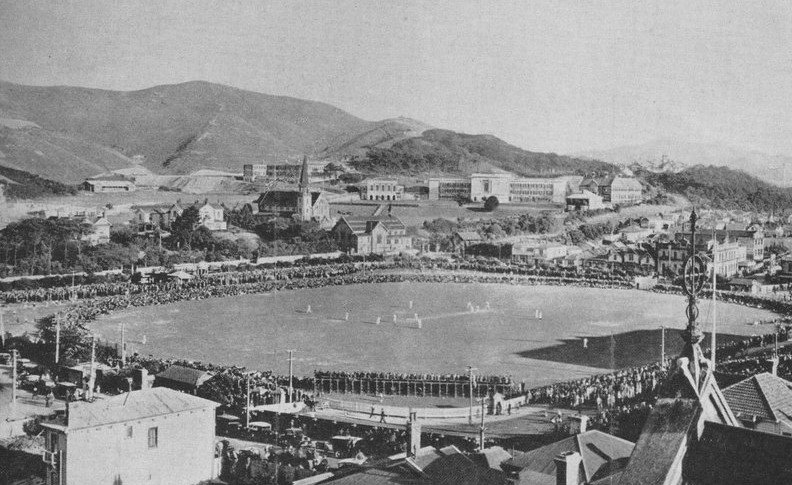This is an old photo of The Basin Reserve, with some history behind the venue and the ground, although this history was written in 1960. The first first-class match in New Zealand took place on the Parade Ground, near Mount Cook Barracks, Wellington, on March 16th, 1860. The little steamer that plied between Auckland and Wellington arrived a little ahead of the expected date, and the local team lost by four wickets. It is recorded that several members of the home team had been engaging themselves at the races during the previous two days and had not had the best preparation that could be desired.’
The Basin Reserve, headquarters of Wellington, C.C., has a fascinating history. It was originally a lake with a river running to the sea, and the original idea of the pioneers was that a canal should be made to the basin, which in turn would be made into a dock or inner harbor. Hence the name Basin Reserve’.
But the 1853 earthquake was responsible for geographical changes; the whole flat was raised, and the Basin Lake turned into a swamp. The cricketers, forced to change their ground, petitioned the local authorities to set aside the basin as a cricket ground and had their request granted. In 1867, the council granted a lease, and the first match between the H.M.S. Falcon and Wellington Volunteers was played on January 1st, 1868.
The organization of the ground into an adequate playing area took a little longer, and the first first-class match was not played there until November 30th, 1873, when Auckland beat Wellington by three wickets. Only six Test matches have been played at the ground: England in 1929–30 and 1950–51, Australia in 1945–46, South Africa in 1931–32 and 1952–53, and the West Indies in 1955–56, but the ground has had its share of excitement.
In 1929–30, C. S. Dempster (136) and J. W. E. Mills (136), the latter in his first Test, gave New Zealand an opening stand of 276—still a record for the country. In 1945–46, New Zealand played their only Test against Australia and were dismissed for totals of 42 and 54, with the visitors winning by an innings and 103 runs even though they failed to total 200.
In 1952-53, D. J. McGlew (255) set up a new record by being on the field for the whole of a four-day Test match, hitting the best-ever score by a South African batsman, and sharing in a seventh-wicket stand of 246 with A. R. A. Murray. McGlew’s inning is the highest hit on the ground by a visiting batsman, but J. R. Reid hit 283 against Otago in a Plunket Shield match in 1951-52.
Other batsmen to hit a double-century are 222 by F. A. Midlane v. Otago in 1914–15, 214* by B. J. Kortlong v. Auckland in 1925–26, 212 by J. S. Hiddleston v. Canterbury in 1925–26, 206 by M. L. Page for Canterbury in 1931–32, 204 by J. S. Hiddleston v. Auckland in 1925–26, and 200* by A. C. MacLaren for M.C.C. in 1922-23. MacLaren’s double-century in 1922–23 holds particular interest, as it was his last innings in first-class cricket, and he had opened his career in 1890 with 108 for Lancashire v. Sussex.
Bowlers have not had a happy time on the ground. T. Eden took 14 wickets for 63 in the match for Nelson in 1875–76, S. T. Callaway took 14 for 65 for New South Wales in 1895–96, and R. W. Blair took 14 for 136 vs. Canterbury in 1956–57.
Four bowlers have succeeded in performing a hat-trick: J. H. Bennett in 1911–12, F. S. Middleton in 1919–20, R. McK. Murray in 1949–50, and J. F. Jones in 1953–54, while five instances of nine wickets in an innings by a bowler (twice by R. W. Blair) have been recorded.
